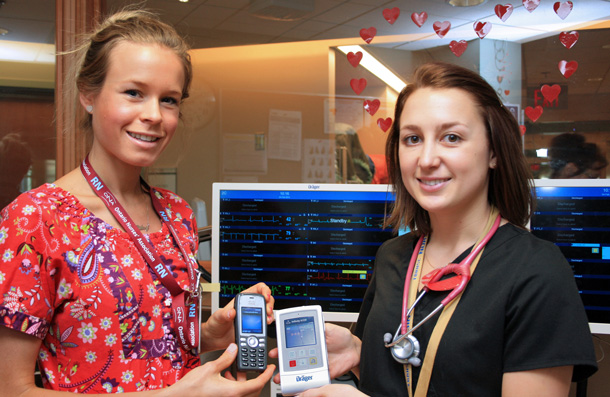

Technology Helps Cardiac Care
THUNDER BAY – HEALTH – Cardiac patients in the Emergency Department and the Cardiovascular Unit (2C) are now safer and more mobile, thanks to a grant from the Thunder Bay Regional Health Sciences Foundation. The new high-tech telemetry packs are a portable monitoring system that measures things like heart rhythm, sending the information back to a central nursing station.
It’s all part of a new large-scale cardiac monitoring system recently installed in several departments throughout the Thunder Bay Regional Health Sciences Centre to replace aging equipment. The telemetry units themselves allow patients who are able to get out of bed to become more mobile instead of being hooked up to a stationary bedside monitor.
“People can have more flexibility to move around – they’re not attached to a bedside monitor while they’re waiting to get their lab tests,” said Lisa Beck, Director of Critical Care & Emergency Services. “Safety is enhanced too because the telemetry packs are wirelessly connected to a central station.”
Previously, if a patient’s heart rhythm went outside of preset limits, an alarm would sound to alert the nurses but it would only display the information at the central monitor. With the new system, not only are the vital signs sent back to central station but they also appear on a display on the patient’s telemetry unit itself.
Nurses also carry a special phone with them at all times to alert them of alarms.
Another advantage of the new system is that it uses the Wi-Fi already in place at the Health Sciences Centre. Previous systems relied upon special antennas to carry information. If the patient went out of range or if the system went down, the alarms wouldn’t work. Now, patients can travel to almost any department in the Health Sciences Centre and still be connected.
“If patients are going to X-ray from the Emergency Department, for example, we can monitor them all the way there and back,” said Adam Vinet, Manager, Emergency/Trauma Services.
The telemetry units also record all critical information and are stored in the system as backup.
“This is another way the new system improves patient safety,” said Wayne Taylor, Manager 2C, Cardiovascular Unit. “If the connection is broken with the central monitoring station, the unit itself continues to monitor the patient. Once the system comes back online, all that information is automatically downloaded to the station.”
The grant for this equipment was possible thanks to donors to the Health Sciences Foundation. For more information about supporting world-class healthcare here at home or to make a donation, call 684-4673 or visit www.healthsciencesfoundation.ca











